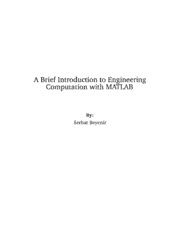Table Of ContentA Brief Introduction to Engineering
Computation with MATLAB
By:
Serhat Beyenir
A Brief Introduction to Engineering
Computation with MATLAB
By:
Serhat Beyenir
Online:
< http://cnx.org/content/col11371/1.8/ >
C O N N E X I O N S
Rice University, Houston, Texas
This selection and arrangement of content as a collection is copyrighted by Serhat Beyenir. It is licensed
undertheCreativeCommonsAttribution3.0license(http://creativecommons.org/licenses/by/3.0/).
Collectionstructurerevised: December1,2011
PDFgenerated: January4,2012
Forcopyrightandattributioninformationforthemodulescontainedinthiscollection,seep. 154.
Table of Contents
Preface ...............................................................................1
StudyGuide ..........................................................................3
1 Introduction
1.1 WhatisMATLAB? ...........................................................5
1.2 ProblemSet ....................................................... .........19
Solutions ....................................................................... 21
2 GettingStarted
2.1 Essentials ......................................................... .........27
2.2 ProblemSet ....................................................... .........46
Solutions ....................................................................... 49
3 Graphics
3.1 PlottinginMATLAB ........................................................55
3.2 ProblemSet ....................................................... .........73
Solutions ....................................................................... 77
4 IntroductoryProgramming
4.1 WritingScriptstoSolveProblems ................................... .........87
4.2 ProblemSet ....................................................... .........97
Solutions ...................................................................... 100
5 Interpolation
5.1 Interpolation ...............................................................107
5.2 ProblemSet ...............................................................111
Solutions ...................................................................... 114
6 NumericalIntegration
6.1 ComputingtheAreaUnderaCurve ..........................................119
6.2 ProblemSet ...............................................................126
Solutions ...................................................................... 128
7 RegressionAnalysis
7.1 LinearRegression ..........................................................133
8 PublishingwithMATLAB
8.1 GeneratingReportswithMATLAB ..........................................143
9 Postscript .........................................................................151
Index .............................................................................. 152
Attributions ........................................................................154
iv
Preface1
IN MY TENTH YEAR AT THE INSTITUTE, I DEDICATE THIS BOOK TO THE BCIT COMMUNITY.
The primary purpose of writing a book and distributing it free-of-charge is to extend my gratitude
to BCIT2 . I am particularly thrilled to do it with this textbook because it is a product of many
learningopportunitiesBCIThasofferedmeoveraperiodofseveralyears. Whatfollowsisabrief
backgroundonhowthisbookcametobe.
Mypost-secondaryteachingcareerbeganon22January2001atthePacificMarineTrainingCam-
pusofBCITwhenIloggedontoaUnixworkstationtoinstructinthePropulsionPlantSimulator.
That has been a major milestone in many ways in my professional life. While learning inner
workings of Unix operating system (OS), I also made a discovery and that discovery profoundly
changed my view on how I thought the world operated. The discovery was the GNU/Linux OS
andopensourcesoftware(OSS)movementthroughseveralbooks,mostnotablyJustforFun: The
Story of an Accidental Revolutionary3 and The Cathedral and the Bazaar4. I was convinced that
thecollectivepowerofconnectedindividualsaroundtheworldandtheglobalinfrastructureofthe
Internethadthepotentialtochangethewaystheworldfunctioned.
In the last 10 years, BCIT has allowed me to study various subjects through its Professional De-
velopment (PD) programs for which I am very grateful. I learned a great deal in PD courses and
in one of the recent ones, I had two déjà vu moments similar to my discovery of OSS movement.
The first one occurred when I began reading The Wealth of Networks5 and the second one when
I found about Connexions6 . The former was a confirmation of my 10-year old discovery and the
latter is what I am using to write this book. Connexions is a web-based curricular content author-
ing and publishing technology that I believe has a growing potential for writing and distributing
free-of-chargelearningmaterials.
Thus, motivation for this book stems from the notions that were generated by the OSS movement.
1Thiscontentisavailableonlineat<http://cnx.org/content/m41458/1.6/>.
2http://www.bcit.ca/
3JustforFun:TheStoryofanAccidentalRevolutionarybyL.TorvaldsandD.Diamond,NewYork:HarperCollins
Publishers. ©2001
4TheCathedralandtheBazaar byE.S.Raymond,Sebastopol: O’ReillyMedia. ©1999
5TheWealthofNetworks byY.Benkler,NewHaven: YaleUniversityPress. ©2006
6http://cnx.org/
1
2
The book was written to pay a small token of appreciation to BCIT and I hope it will be a contri-
butiontotheopeneducationalresourcesrepository.
SerhatBeyenir
NorthVancouver,B.C.
25October2011
Study Guide7
MATLAB, a sub-course of Computer Technology 1 and this text are specifically designed for
studentswithnoprogrammingexperience. However,studentsareexpectedtobeproficientinFirst
Year Mathematics and Sciences and access to good reference books are highly recommended. I
also assume that students have a working knowledge of the Mac OS X or Microsoft Windows
operatingsystems.
The strategic goal of the course and book is to provide learners with an appreciation for the role
computationplaysinsolvingengineeringproblems. TheMATLABspecificskillsthatIwouldlike
studentstoacquireareasfollows:
• Write scripts to solve engineering problems including interpolation, numerical integration
andregressionanalysis,
• Plotgraphstovisualize,analyzeandpresentnumericaldata,
• Publishreports.
The best way to learn about engineering computation is to actually do it. We will therefore solve
many engineering problems mainly using a recent version of MATLAB in this book. Since the
primaryfocusisengineeringcomputation,wewillconcentrateonthemathematicalsolutionsand,
toalimitedextent,thegraphicaluserinterface(GUI)featuresofMATLAB.
Learning a new skill, especially a computer program, can be an overwhelming experience. To
make the best of this process, students are encouraged to observe the following guidelines that
haveproventoworkwell:
• Plantostudy2hoursoutsideofclassforeveryhourinsideofclass,
• Practice, practice, practice: As the old saying goes, practice makes one perfect or perhaps
weshouldmodifythatstatement: Goodpracticemakesoneperfect,
• Buddy system: Study with a classmate. Helping one another drastically improves your
understanding of the material. Particularly, students are advised to work the problem sets in
thisfashion,
• Muddy points: Make a note of muddy points as they may occur during lectures and email
yournotestome. Iwilladdressthoseissuesatthebeginningofthenextclass,
• Open book exam: Do not try to memorize commands, functions or their syntax but learn
where and how to find that information. Through many exercises and problem sets you will
7Thiscontentisavailableonlineat<http://cnx.org/content/m41459/1.2/>.
3
4
havesolvedbytheendofthecourse,mostcomputationalroutineswillbecomesecondnature
toyou. Theexamisopenbook,sokeepyourlearningmaterialsandm-fileswellorganized.

